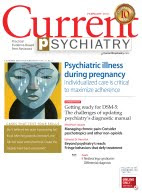Michael T. Sorter, MD, Associate professor of psychiatry and pediatrics, Department of psychiatry, University of Cincinnati, Cincinnati Children’s Hospital Medical Center, Cincinnati, OH
Admitting an adolescent to a psychiatric inpatient facility may be necessary to address a crisis. Interdependent links among the patient, family, and support network complicate the determination of whether an adolescent requires inpatient care. To make the best decision, a psychiatrist needs to understand the youth’s difficulties within family, school, and community.
The decision to admit an adolescent rests on:
the clinician’s ability to evaluate the risk of harm and functional status
how much support the family and/or caregivers can provide
the clinician’s knowledge of treatment resources available to the adolescent and family.
Comment on this article
Email the editor


